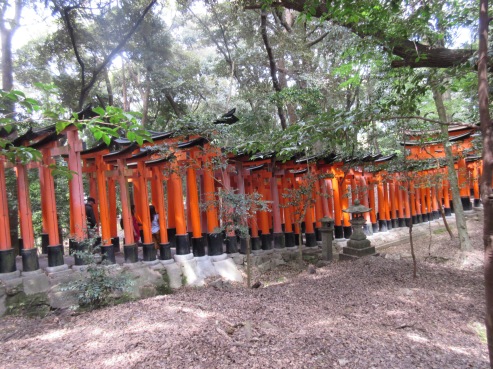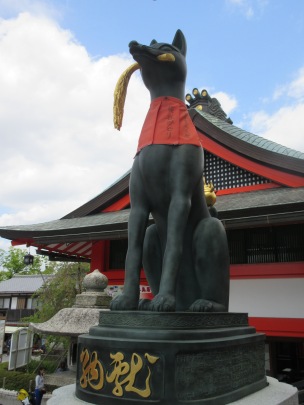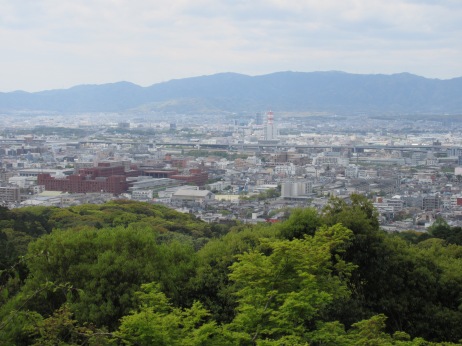
I lived in Japan for many years when I was young, and visited Kyoto at least 5 times in the past. I have never known about Fushimi Inari Taisha until I started doing my research for my April 2017 trip. It was rated #1 in Tripadvisor Kyoto attraction.
Since I didn’t know this place existed in the past, I was very curious, and decided to make a visit. I read up on the topic, researched how to get there, and made my trek in April.

Inari means fox, and there are many statues of fox guarding all the shrines. Japanese people believe that the foxes are cleaver and can outsmart the evil spirits. In the little tea houses on the road to the top, you see Inarizushi which is named after Inari (fox). Inarizushi is sushi rice stuffed in the thin tofu skin. If you imagine stuffed pita bread, it’s the same concept. The color of the tofu skin is light brown just like foxes.
The rows of red gates were beautiful in the background of green, and there are many many little shrines along the way to the top of the path. The Inari shrines stand for prosperity, thus all of the vermilion gates were dedicated by businesses to get blessed for business prosperity. The bigger the gate is, the higher the dedication money is.

You have a choice of doing the entire loop path, or turn back at the midpoint with a nice lookout area. Since we made a trek to visit, we decided to do the whole loop to the top of the mountain. It was a sunny day with high of 70, but during the hike, we were sweating from head to toe. It was a humid day just like any other normal day in Japan, and you get to drench in sweat. After following the directions at branch points, we hit the top of the mountain in about 1 hour.
I thought the top of the mountain was rather anticlimactic, since it was no different from the rest of the mountain path. Lots of little shrine guarded by small foxes, but they are the same visually with the thousand others shrines on the path. I think I would turn back after the midpoint lookout if I ever go back there next time around. I just didn’t know what was at the top, so I just had to go and find out.
The torii (pronounced tory-e) gates were indeed beautiful, take gorgeous pictures. It’s very easy access from JR Inari station on JR Nara line. Some Kyoto attractions are hard to get to with public transportation, so it’s a great thing to have easy access by JR trains. In addition, the attraction is free to the public! All other shrines and temples in Kyoto will cost at least 500 yen entrance fee.
The highlight of the Inari Taisha hike was the street food vendors at the bottom of the hiking trail. We worked up our appetite with the hike, and everything looked and smelled wonderful! We shared Okonomiyaki (Japanese pancake), Inarizushi (fried tofu wrapped sushi rice), Wagyu on a stick, and Taiyaki (Japanese fish shaped sweets with waffle like shell with red bean inside). It was one of the best meal on the trip to be able to taste varieties of street food.
Fushimi Inari Taisha, for the most part, became famous and so popular with Kyoto visitors after it was discovered by foreign visitors and became a social media sensation. Thousands of vermilion gates take great pictures and the idea of hiking into the mountain full of gates stirs up vivid imagination. Fushimi Inari was popular with locals in the past, but only on the New Year’s holiday, it attracted thousands of worshipers. Currently, it attracts thousands of tourists every single day of the year thanks to the strong social media exposure.
Side Note:
I strike up a conversation with a local Kyoto gentleman who helped me with the train direction. He used to work for the visitor commerce office of Kyoto city office, and he was familiar with the changing face of recent visitors to Kyoto. He said that most of the Kyoto visitors are from foreign countries, and the city was having a hard time trying to keep up with the infrastructure to accommodate the foreign tourists. Most of the signage I saw in Kyoto was in romaji (English), but smaller attractions still have old Japanese only signs. Updating all the signs throughout the city is a daunting task, since there are hundreds of small shrines and temples throughout Kyoto area,



Incredible!
I’m heading to Japan in 2 weeks and can’t wait!!
Definitely heading to Fushimi Inari, your photos are real nice – cant wait to take some of my own!
LikeLike
Interesting place!
LikeLike
We got lost in there with all the torii gates and took 2 hours to walk out!
LikeLike